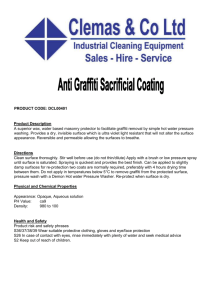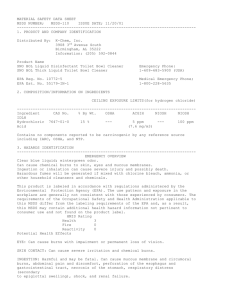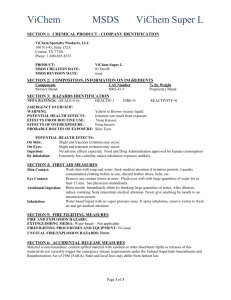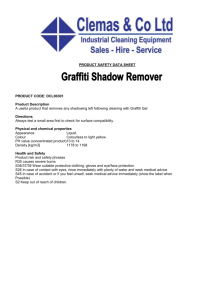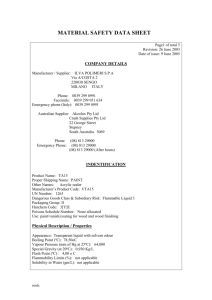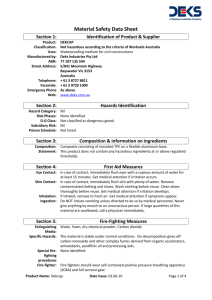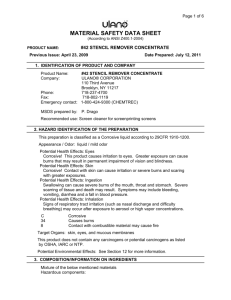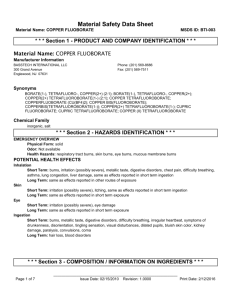Fracking chemicals, their uses and hazards
advertisement
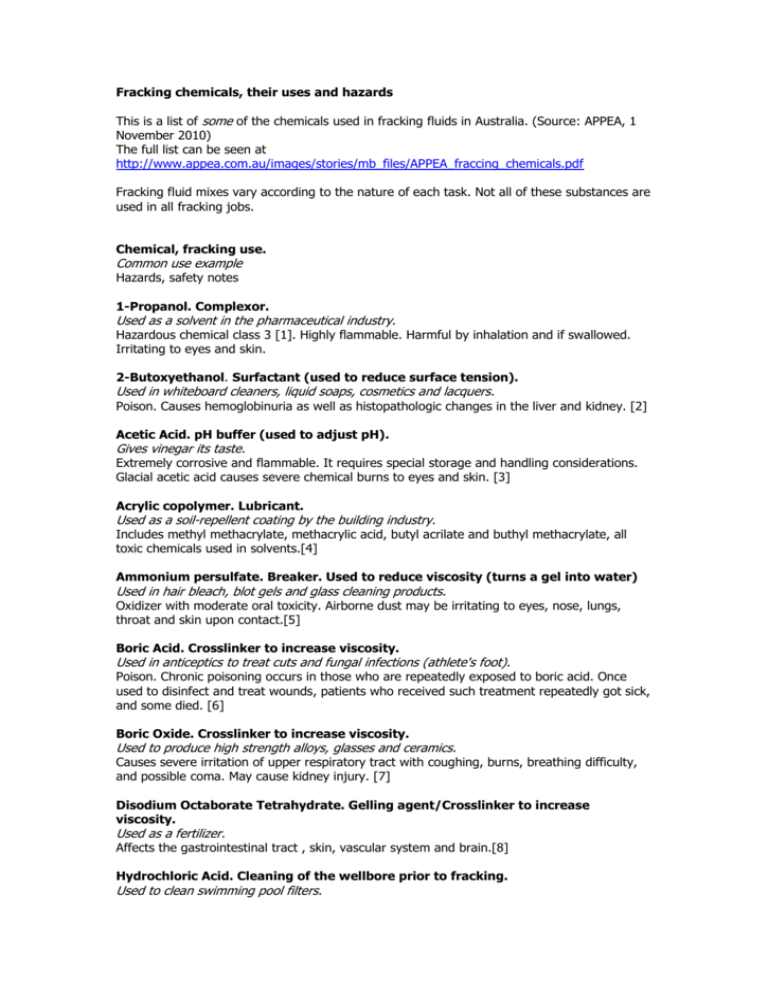
Fracking chemicals, their uses and hazards This is a list of some of the chemicals used in fracking fluids in Australia. (Source: APPEA, 1 November 2010) The full list can be seen at http://www.appea.com.au/images/stories/mb_files/APPEA_fraccing_chemicals.pdf Fracking fluid mixes vary according to the nature of each task. Not all of these substances are used in all fracking jobs. Chemical, fracking use. Common use example Hazards, safety notes 1-Propanol. Complexor. Used as a solvent in the pharmaceutical industry. Hazardous chemical class 3 [1]. Highly flammable. Harmful by inhalation and if swallowed. Irritating to eyes and skin. 2-Butoxyethanol. Surfactant (used to reduce surface tension). Used in whiteboard cleaners, liquid soaps, cosmetics and lacquers. Poison. Causes hemoglobinuria as well as histopathologic changes in the liver and kidney. [2] Acetic Acid. pH buffer (used to adjust pH). Gives vinegar its taste. Extremely corrosive and flammable. It requires special storage and handling considerations. Glacial acetic acid causes severe chemical burns to eyes and skin. [3] Acrylic copolymer. Lubricant. Used as a soil-repellent coating by the building industry. Includes methyl methacrylate, methacrylic acid, butyl acrilate and buthyl methacrylate, all toxic chemicals used in solvents.[4] Ammonium persulfate. Breaker. Used to reduce viscosity (turns a gel into water) Used in hair bleach, blot gels and glass cleaning products. Oxidizer with moderate oral toxicity. Airborne dust may be irritating to eyes, nose, lungs, throat and skin upon contact.[5] Boric Acid. Crosslinker to increase viscosity. Used in anticeptics to treat cuts and fungal infections (athlete's foot). Poison. Chronic poisoning occurs in those who are repeatedly exposed to boric acid. Once used to disinfect and treat wounds, patients who received such treatment repeatedly got sick, and some died. [6] Boric Oxide. Crosslinker to increase viscosity. Used to produce high strength alloys, glasses and ceramics. Causes severe irritation of upper respiratory tract with coughing, burns, breathing difficulty, and possible coma. May cause kidney injury. [7] Disodium Octaborate Tetrahydrate. Gelling agent/Crosslinker to increase viscosity. Used as a fertilizer. Affects the gastrointestinal tract , skin, vascular system and brain.[8] Hydrochloric Acid. Cleaning of the wellbore prior to fracking. Used to clean swimming pool filters. Extremely corrosive. Inhalation of vapour can cause serious injury. Ingestion may be fatal. Liquid can cause severe damage to skin and eyes. Threshold Limit Value - 5 ppm. Lethal to fish from 25 mg/l or more. Toxic for aquatic organisms due to pH shift [9] Methanol. Surfactant. Used to aid gas flow. A type of alcohol, can be used in wastewater treatment and as an alternative fuel. Swallowing even small amounts has potential to cause blindness or death. Effects of sub lethal doses may be nausea, headache, abdominal pain, vomiting and visual disturbances ranging from blurred vision to light sensitivity. Repeated exposure by inhalation or absorption may cause systemic poisoning, brain disorders, impaired vision and blindness and worsen conditions such as emphysema or bronchitis. [10] Ethylene Glycol Monobutyl Ether. Mutual solvent. Used in household cleaners, fire fighting foam, and to degrease bowling pins and lanes. Liquid and vapour are combustible. Harmful if inhaled, when in contact with skin and if swallowed. It is irritating to respiratory system. Causes eye irritation, affects central nervous system, blood and blood forming organs, kidneys, liver and lymphoid system. [11] Muriatic Acid. Used for cleaning the well bore. Leather tanning and for cleaning. Irritating and corrosive to living tissue. Brief exposure in low levels produces irritation. Exposure to higher levels can cause breathing difficulties, narrowing of the bronchioles, blue colour of the skin, accumulation of fluid in the lungs and death. [12] Potassium Chloride. Clay inhinbitor. Used in making fertilizer, gas-welding flux, in medicines and for lethal injections. Large doses cause gastro-intestinal irritation, purging, weakness and circulatory problems. [13] Polydimethyldiallylammonium chloride. Clay control. Flocculant in waste water treatment. Wetting agent, shampoo ingredient. Avoid runoff into storm sewers and ditches. [14] Quaternary Polyamines. Clay control. Used in waste water treatment Corrosive, dangerous for the environment. Risk of serious damage to eyes. Very toxic to aquatic organisms. Vapours may cause drowsiness and dizziness.[15] Sodium Borate. pH buffer. A component in glass, pottery, and detergents. Eye irritation, blurred vision, eye damage. [16] Sodium Hydroxide. pH buffer. Used in paper-making, food processing, soap, detergents, drain cleaners. Causes severe skin and eye burns. May cause blindness; severe and permanent damage to gastro-intestinal tract including burns, perforations[17]. Inhalation may lead to chemical pneumonitis, pulmonary edema. Causes severe irritation of, and possible chemical burns to upper respiratory tract – coughing, burns, breathing difficulty. Possible coma. Tetrakis (hydroxymethyl) Phosphonium Sulfate. Antiseptic. Used to elimate bacteria in water, petroleum. Prolonged or repeated skin contact may cause dermatitis, liver and kidney damage. [18] Tetramethyl ammonium chloride. Clay control . A salt of ammonia. Few common applications. May be fatal if swallowed. Causes dizziness, nausea, shortness of breath, severe hypotension, shock. A known ganglionic blocking agent, causing vasodilation, and curare-like actions, peripheral nerve damage, cardiac paralysis, dyspnea, effects, hypotension.19 References: [1] http://www.phmsa.dot.gov/staticfiles/PHMSA/DownloadableFiles/Files/erg2008_eng.pdf 2 http://www.csr.com.au/msds/MSDS/n-Propanol.pdf 3 http://www.valdezlink.com/inipol/pages/2-butoxy_msds.htm 4 http://www.lyondellbasell.com/techlit/techlit/3324.pdf 5 http://las.perkinelmer.com/content/ApplicationNotes/FAR_GCMSAcrylicCopolymerPyr.pdf 6 http://www.hillbrothers.com/msds/pdf/n/ammonium-persulfate.pdf 7 http://www.nlm.nih.gov/medlineplus/ency/article/002485.htm 8 https://securesearch.acros.com/msds?for=acros&sup=acros&lang=UK&search=206300010 9 http://www.pesticideinfo.org/Detail_Chemical.jsp?Rec_Id=PC35343 10 http://msds.chem.ox.ac.uk/HY/hydrochloric_acid.html 11 http://www.methanex.com/products/documents/MSDS_USenglish.pdf 12 http://www.ppci.com.ph/msds2k10/04_egmbe.pdf 13 http://hubpages.com/hub/What-is-Muriatic-Acid 14 http://www.flocculants.info/Gmsdsdmdac20.pdf 15 http://www.broadleyjames.com/PDFs/msds-kcl-h2o.pdf 16 http://duoclean.de/web/WebE.nsf/0/346FD2D62F6D8F56C12577E500364F78/$FILE/neosepta l%20plus_GB-en_2009-10-19-PN2158.pdf 17 http://www.transgenomic.com/lib/msds/CAR990061.pdf 18 http://www.certified-lye.com/MSDS-Lye.pdf 19 http://www.caledonlabs.com/upload/msds/8650-5e.pdf
